Before I start, I already know I will get some comments on the canning process I chose to use here, but that’s okay. I am going to share the most preferred method as well, so you can choose which method YOU prefer.
But, for now…have you ever tried Mormon Beans? Oh my. I never have, until yesterday. I came across a recipe that looks interesting, which often gets me into a bit of trouble, to be honest.
However, this was definitely the exception to my experience. I was very pleasantly surprised, because they tasted even better than I thought they would.
So, what do you need to make this recipe? Take a look at the list below.
Ingredients
- 1/2 pound ground beef
- 1/2 pound bacon
- 1/2 onion, chopped
- 1 teaspoon salt
- 3/4 cup brown sugar
- 1 teaspoon dry mustard
- 2 teaspoons vinegar
- 1/2 cup catsup
- 2 cans pork & beans
- 1 can kidney beans, drained
- 1 cup sweet chili sauce
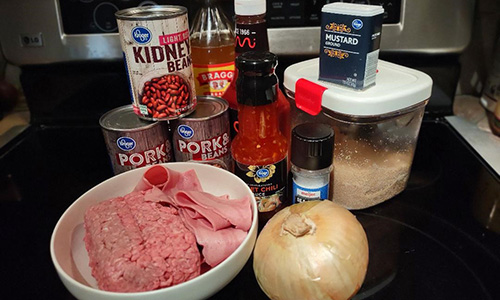
I used turkey bacon, because we are trying to get healthier in my household. But, I think regular bacon is better! I had apple cider vinegar on hand, so I used that instead of standard vinegar.
And, I also did not add the salt, but only because I forgot. However, I didn’t miss it either.
Some recipes call for a can of green beans, in addition to the other beans. But, I am not a fan of green beans, so I left those out.
How to Make The Mormon Beans
I was a little surprised at how small of a batch this created, after I started placing it in the jars. It only made 4 pint jars. So, I will at least double it next time!
I added the chopped onion to the ground beef, then cooked the beef fully with a little browning for additional flavor. Then set aside.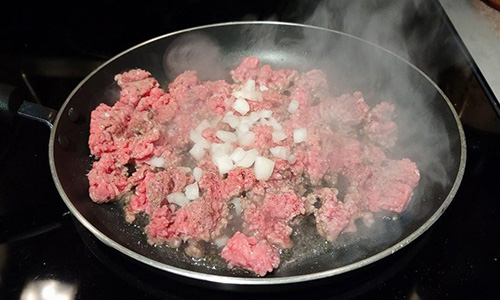
Cook and brown the bacon.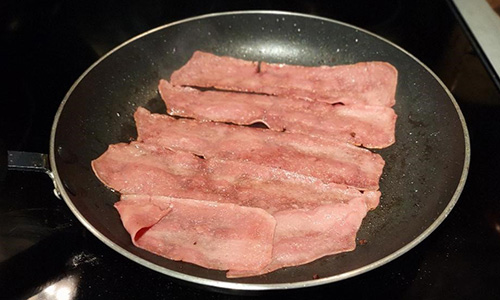
Add the bacon to the ground beef and onion.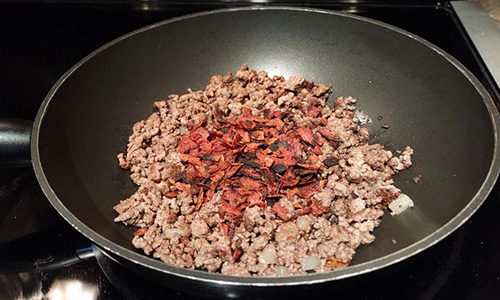
Add the remaining ingredients.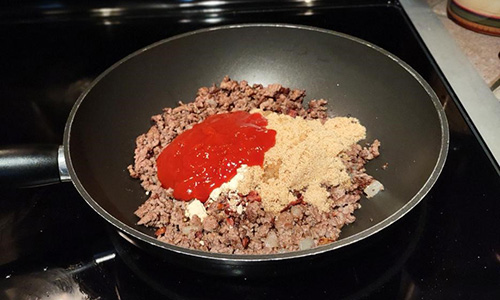
Cook and bring to a light boil. You are now ready to can!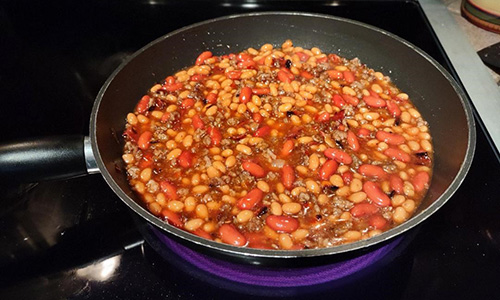
NOTE: If you don’t drain the beans, there should be enough liquid to properly can. If the cooked mixture seems dry, add some beef broth to the jars, but don’t go above the neck.
Related: How To Can Bone Broth At Home With 2 Years Shelf Life
Canning with a Hot Water Bath
Again, this might not be YOUR ideal way to can something with meat in it. But, I will be keeping these outside in my garage.
And, with winter coming up, that’s like an unplugged refrigerator, or even a freezer at times. Until it gets cold enough though, I will keep these in the fridge for a couple more weeks.
Supplies needed for this include:
- Canning pot with rack at the bottom
- Jars
- Lids and rings
- Jar lifter
- Wide mouth funnel
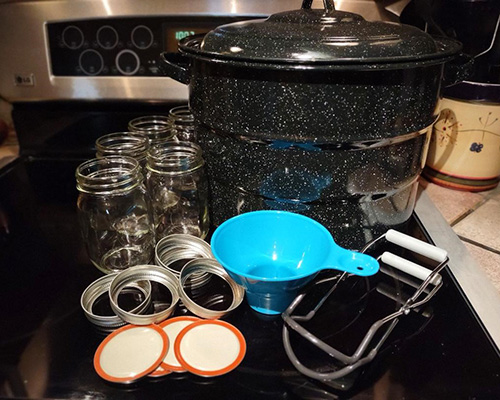
Start by washing and sanitizing the jars, lids, and rings. Although, there is debate now whether or not sanitizing is a necessary step, if they are in the boiling process for 10 minutes or longer.
You be the judge of what you are personally comfortable with, just like the canning method. I washed and sanitized, mainly because I was already pushing the comfort level with the canning process I chose.
Related: 7 Deadly Canning Mistakes Even Smart People Make
Start heating the water in the canning pot. There should be enough water to cover the closed jars by 1-2 inches.
Using a wide mouth funnel, add enough of the Mormon beans to the jar to leave 1” headspace. That should be right up to the neck of the jar.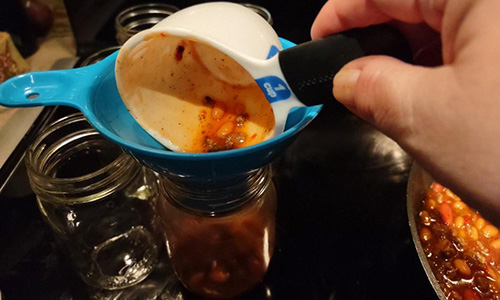
Wipe the rim of the jars to make sure they are clean. That will make sure it has a good seal.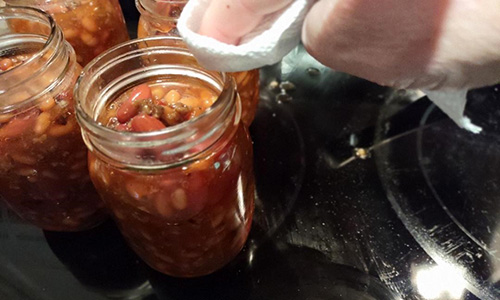
Place the lid on the jar, firmly. But, don’t push down. The center of the lid should still be flexible when pushing down lightly. This is important later, to know you have a good seal.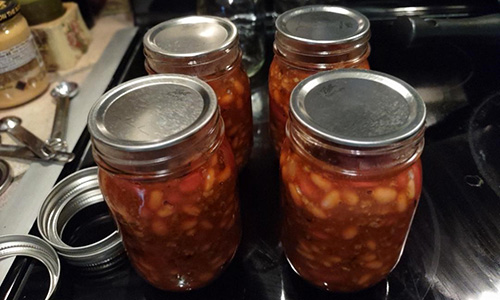
Screw the ring over the lid, making sure it’s on securely.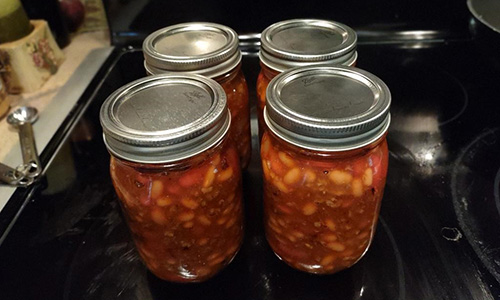
Using the jar lifter, carefully place the jars into the hot water. I added some water-filled jars into the pot with them, filling the pot up a bit more to help avoid too much moving during the process.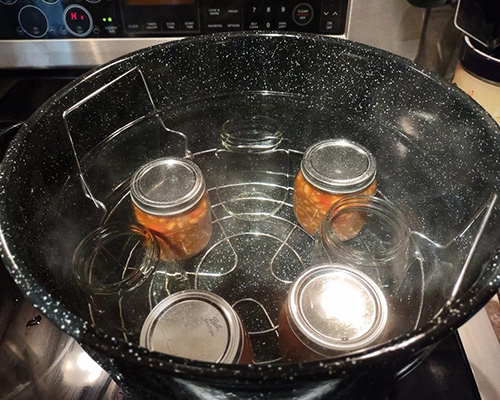
Place the lid on the canning pot, and let it come to a boil. Once it starts boiling, that is when you can start your timer.
Here is the tricky part…how long? I found various opinions on how long it should be in the process. So, I went with the longest, which was 3 hours.
Carefully remove the jars with the jar lifter, and set on a towel, but not touching each other. Lightly wipe down, and let them sit. You will then start to hear the lids popping…such a beautiful sound of accomplishment!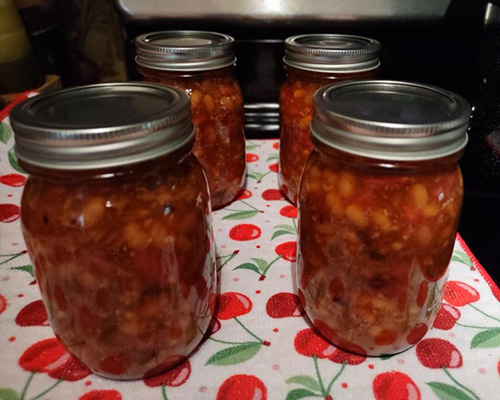
The shelf life for this bean recipe with the water bath method is unsure. I plan on keeping mine on the shelf through the winter, if they last that long. Yes, they are THAT good!
But I’m sure many people will find this method questionable. So, for those who prefer using a pressure canner method, here you go.
Follow the same steps in making the Mormon Beans, as well as jar prep. Here is where it begins to differ.
Using a Pressure Cooker
Again, prepare the beans and jars just as you would in the water bath method. But, then follow these steps…
- Heat the water in the pot
- Place the filled jars into the pot.
- Put the pot’s lid on, but leave the weights off for now.
- Bring the water to a boil (you will start seeing steam).
- Let the steam vent for 10 minutes, then place the weights on. (Use the proper weight for your altitude, listed at the end of the article)
Related: 7 Primitive Cooking Methods You Still Need to Know Today
The pressure will start building at this point. And, when the pressure reaches your goal, start your timer…NOT before.
Watch the pressure to make sure it remains consistent. You can adjust the temperature to adjust the pressure, if necessary.
When the processing time is complete, turn the heat off. But, DON’T remove the weights just yet. You need to let the canner sit, undisturbed, until the pressure comes back down to zero.
Once it reaches zero, you can remove the weights…then wait another 5 minutes.
Next, open the pot’s lid…AWAY from you, to allow the steam to escape. Let the lid sit on the pot, but slightly off so more steam can release, for another 5 minutes.
Take the lid off, and carefully remove the jars with the jar lifter.
Just as with the water bath process, place the jars on a towel, but not touching. Let them cool down, and listen for the popping!
Processing time for this recipe is 1 hour and 15 minutes for pint jars, and 1 hour and 30 minutes for quart jars.
The pressure will change based on altitude. But, here is a guide to help you know.
Altitude for weighted Gauge:
- 0-1,000 ft – 10 pounds
- 1,001-8,000 ft – 15 pounds
Altitude for dial gauge:
- 0-2,000 ft – 11 pounds
- 2,001-4,000 ft – 12 pounds
- 4,001-6,000 ft – 13 pounds
- 6,001-8,000 ft – 14 pounds
Canning with the pressure canning method should allow you to keep Mormon Beans on the shelf for up to a year without losing any quality. After that, they would still be considered safe for years.
You may also like:
 How to Create a Vehicle Emergency Kit
How to Create a Vehicle Emergency Kit
The Succulent Red Plant That Tastes Like Bacon (Video)
Survival Uses For Animal Bones You Normally Throw Away

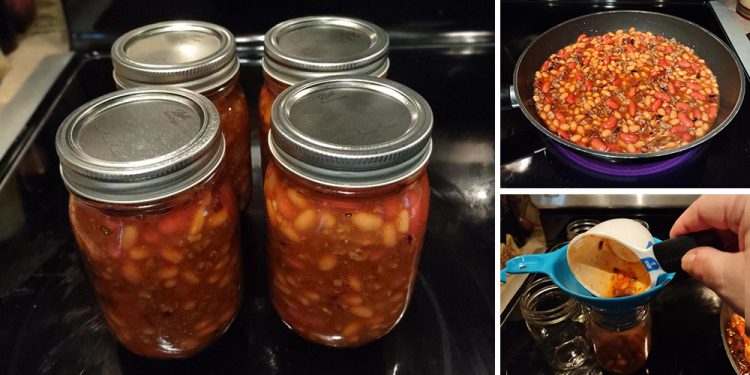













Most expensive canned beans I’ve heard of. More an sweet (from pork and beans plus sugar) chili.
I almost feel silly that I am processing the carcass of a 47 cent a pound roasted turkey and cooking up a pound of dried navy beans @ 1.39 a pound to make almost 6 full sized meals for myself and my beautiful wife. With the addition of some white rice @ less than a dollar a pound that turkey soup is 8 full sized meals.
At the price of bacon my whole turkey cost less than this recipe.
Oh and my Dogs get a nice Thanksgiving week of treats from my carcass. Yes I know not to feed Dogs cooked bones but cooked in to bone mush they Love it.
Learn how to cook with cheap basics while you have the luxury to toss errors and order a pizza.
Going to suck trying out those “Survival Foods ” under stress AND doing the Learning Curve of that No Grid campfire.
Well you’re braver than I am! Although it’s Interesting, but it is not for me. If I am going to store food, I want a longer shelf-life than the two years homemade canned goods provide. I also want the assurance that what I’ve got stored has been prepared well, something I as a novice may not do. There is no cost savings for me if I buy at a market to put things up. I know practice makes perfect, but one can only grow so much, buy so much, and eat so much and I do not like to waste food. Growing up, that was considered sinful in our home. I’ll stick to pickling and jams.
As long as the jar is sealed and canned properly it lasts a very long time. I opened a can of tomatoes from 2015 and they were good. I can meat, which will last for years. It is the government and the idiots that own canneries that say you can only keep canned goods for that amount of time. I make my own Mormon Beans, but not with all of that sweet stuff. We have had them over 4 years and they are still good. You do lose some quality, but it us better than starving. I made Spam with a shelf life of 25 years. That is meat, so as far as I am concerned. Change the recipe to what you like. You have a lot of protein and the added carbs just gives you more calories when you need them.
That’s right; when I prepare I do so to protect my family and I give them the very best I can possibly provide. I love them and they are worth doing it right. To do otherwise puts their lives at risk.
Karenkay, by what recipe and process did you make Spam with a 25 year shelf-life? Can you share the science and testing results? Or are you making this based on something you read in the Internet from some prepper who is also making Spam to kill their families?
Which foods are you buying with a longer-than-two-year shelf life? Dehydrated stuff?
Did you double or triple the quantity to account for the over-promising by the companies that make the meals?
Did you calculate the water required to cook all that dehydrated stuff and are you storing that much water? Even more water than that? Otherwise, how do you plan to get the required water in the required quantity when the spigot shuts off?
If you’re counting on an EOTW situation longer than 2 years – since you want a longer-than-two-year shelf life – then you better have more than 2 years of dehydrated stuff and water.
I know you’re a regular poster on this site and you’re generally knowledgeable about prepping but your “city” roots are really showing here. For one thing, canned foods – whether from the store or your own, will contain water. They will help keep you alive when the spigot shuts off.
Buy canned foods or can your own for at least short-term survival. Learn to cook with canned foods. I was raised poor, as was my wife, so we were both raised on a lot of canned foods and we eat a lot of them to this day.
One advantage that home-canned food offers is that you have the skill to can your own when the shelves are bare. My recommendation for city-folk is to know how to can and to work on all of the many alternatives there are for raising your own food to can, even in a city.
CC – Hopefully, you are eating what you’re storing, i.e., rotating your stock and not just buying stuff to put away and not use until an emergency arises. Home canning is a lot of work. We each have to decide if we have enough readily-available ingredients at a reasonable cost (and time and equipment) to make it worthwhile, either on a cost or quality basis. I think for many of us who don’t have ready access to ingredients except through the supermarket, canned goods, rice, and pasta may be a more realistic way to go. I do remember, though, picking buckets of black raspberries for my mom to make jelly. Delicious.
Update on the turkey carcass soup a thick one.
Cooled it and a nod to “Modern Cooking ” skimmed off fat. Dogs are currently overjoyed as I added some to their food. Nice shiny coats and bright eyes.
In harsher times I’d keep more of the fats as extra physical labor requires it. My dogs being working dogs still get some.
Adding some carbs to it and some veggies and peppers as my garden grows plenty. Carbs could be rice or potatoes or pasta or Even squash. Depending on flavor profile and post SHTF availability is the choice of the day.
Most have plenty of firearms, some plenty of food, very few have water really worked out (as in silly ideas never tested about hauling buckets of nasty surface water @ 8 POUNDS a Gallon HOW FAR? AND Using a water filter properly) and fewer still test cooked their “Survival Foods” .
You may have to defend yourself but you WILL BE Eating, Drinking Water AND Another common weakness of most preppers I know No Realistic Plans to handle the human waste. 3rd World DISEASES inbound Self Inflicted And PREVENTABLE.
Give Thanks for the Grid power, the cheap food, and the health of your family this Thanksgiving as that Might not be the same next year.
Being kind costs $0.00. Save yourself even more by shutting tf up and not commenting when you have nothing to say but insults. Not everyone cans to save money or for doomsday prepping. Sometimes mom’s with kids like to make yummy things in bulk so they can pop it open later for a hot meal that’s not always bland turkey and rice for the family and still have the time to read that extra story at bedtime or snuggle just a little longer before they get ready for bed because “time” is more important spent with the ones you love. It must be difficult to only see past your nose sir. You should work on that before scorning others for having different reason than you for canning. Have a better day. I hope you spend more of it with your beautiful wife.
What about straining the bone “mush” to get the bone broth before giving the solids to the “best friends.”
What size cans on the pork and beans and kidney beans? thanks
So??
You opened 3 cans to make 4 cans??
The recipe sounds great for family dinner, but doesn’t seem cost effective in the long term.
Maybe, use dried kidney beans? And pink beans and dilute the meat ingredients so you can make a couple cases???
Once the recipe is ready for canning, use a piece of litmus paper to get the pH. If it is a higher number than 4.6 then pressure can. If it is well under 4.6 then you can water bath can. This does NOT appear to have enough acid in it to water bath can. Be careful out there. The recipe sounds yummy, with canned beans OR dry beans used.
Do you have any science to back that up? Any pictures of your laboratory? By your suggestion, you could add citric acid to get to the right Ph and can meats by water bath.
Why would anyone put their family at such risk? Do people not love their families enough to follow the science of safe food preservation and handling?
Dale, I recommend you do a little more homework on this issue before canning yourself or telling others what is right or what to do. I am a Master Canner. How much do you can? Just let it go. Do what you need to do,, Quit virtue signaling. No one minds how you do it. Do it as you need to.
Laureen, you’d lose your master canner certification if your county agent knew you were suggesting to can meats by water bath.
I’ve been canning for over 50 years. But neither my greater experience, nor your piece of paper, replace the science that says what you’re suggesting is unsafe and can kill people.
This is not virtue signaling, this is arguing against you and others recommending practices proven scientifically to be unsafe and dangerous. If I am wrong, quote the science that backs you up.
The USDA created the water bath instructions in 1917 and pulled them in 1946 when the USDA went from anecdotal evidence to scientific evidence in the 40s, they removed any recommendation for waterbath cooking of meats. This is not new; it is 80 years old.
https://nchfp.uga.edu/publications/usda/review/origins.htm
Waterbath canning for meats is NOT what you were taught in any legitimate master food preserver class.
The California master food perserver canner page has these two items as part of the role of master food preserver:
* Prevent botulism in home canning
* Promote research-based methods of food handling and food preparation
https://mfp.ucanr.edu/Volunteer/Become_a_Master_Food_Preserver/
From the Maine Master Food Preserver program description:
Master Food Preservers serve to extend Extension’s education programs in food preservation to adults and youth. The Master Food Preserver serves as a volunteer and as a resource in the community to provide the public with research-based information from the University of Maine Cooperative Extension and USDA.
https://extension.umaine.edu/food-health/food-preservation/master-food-preservers/
Notice Maine also says research-based information – adding “from the University of Maine Cooperative Extension and USDA”. You won’t find waterbath canning for meats in the Cooperative Extension or USDA guidelines.
I might generally try to be more nice and less assertive in a place where I am a guest, such as on this website, but I’ll say that you are full of CRAP and you should not have a master food preserver certification. I’m being direct and to the point because this is not about your feelings, this is about people’s lives. Your piece of paper doesn’t mean SH*T when you’re making it up and not following the guidelines of the program. Just how the heck would you sleep at night if someone followed your advice, after all you are (or claim to be) a master canner, and died?
People, do NOT can meats with water bath. That one person or a thousand people online tell you that they did it and didn’t die is NOT science. I did it and it didn’t kill me is NOT science.
You need 240 degrees – pressure cookingt temps – to kill botulism. Did they not teach you in your class or did you buy the certificate?
as a registered nurse i can’t go along with the waterbath canning. the botulism toxin is not that common, but when it is present, it is deadly. pressure canning for me! i wonder about re-canning store-bought beans. i would think they would nearly disintegrate. why not make your own? much cheaper and easy. i do regularly make and can a pork and beans recipe that is well received. as for the two year business, that is a conservative estimate. store your canned goods cool and dry and they will maintain QUALITY for more than two years. and they will remain safe to eat for as long as the seal holds. you do listen for the “whoosh” of the vacuum seal breaking with both home and commercial canned goods, right? the quality loss in long storage is usually a texture and color change. in commercially canned goods, old canned goods begin to taste metallic if they are acid based–that is friuts and pickled foods.
Interesting recipe. I’ll have to try it, although I’d likely adjust the sugar since I prefer beans that are more savoury than sweet.
I know people who still wb (water bath) meats for three hours. I prefer to pressure can those. It requires less energy from your stove, and pressure canning allows the temperature to go higher than the boiling point, around 240 degrees F if memory serves.
With such a long WB time, you have to check your water level. If it gets to where it’s not covering the jars by an inch or two, you need to add more boiling water. The boil needs to keep going the entire time. If it stops, you’re supposed to reset the processing clock and start over.
The pc (pressure canning) process from start to finish might take about the same amount of time as the WB method because you have to allow the water to boil, let the canner vent for ten minutes before putting on the weight or closing the petcock to start building pressure, wait for the pressure to reach where you need it to be, process, and then the cool down time takes a while.
In either case, when you remove the jars from the canner, you want to allow them to cool in a draft-free place. A draft can cause the jars to crack. Ditto a cold counter, which is why you want a towel or some cushioning on the counter top when you put your jars there. You want at least an inch of space between jars so air can circulate.
The contents of the jars can still be boiling when you remove the jars from the canner, and may boil for quite a while afterwards.
After several hours or overnight to allow the jars to cool, check the seals. If using two piece metal lids, remove the band, and see if you can lift the jar by the lid. If so, the lid sealed properly. If the lid comes off, then store that jar in the fridge and eat the contents in the next few days. Or freeze them for longer term storage. Or reprocess putting them in the canner again. I don’t like to reprocess as things get too mushy for me, but ymmv.
After checking the seals, you want to wash the outside of the jars, since some siphoning may have occurred during processing, and you don’t want any food particles sticking to the outside of your jars. That’s a potential welcome sign for rodents looking for food. The threads on the jar can feel sticky after processing, even if there is no siphoning, so washing them afterwards is a normal step for me. You also need to wash the bands well. They do not need to be on the jars when you store them. Some will tell you NOT to store them with the bands on, as that can create a false seal. That happens when the lid loosens for some reason, but the band doesn’t let it pop completely loose.
Label your jars with contents and date. Storing in a dark, cool place is best.
For thise that are new to canning, pick something easy to prepare. Some people will try canning water their first time out. It allows you to follow all the steps, and should you mess up, you haven’t wasted food, and it’s easy enough to use the water.
Older canning books caution you to boil the contents for 10 minutes before eating as that will render any botulism that might have formed impotent. Modern canning books have dispensed with that 10-minute boil rule. They have also dispensed with WB meats and other low-acid foods saying only to use a PC.
I use a PC but I more often than not do the ten-minute boil. Old habits die hard sometimes.
Even if you live in the far north and have reliably cold temps in your garage, it is reckless to suggest to novices that meat can be canned with a water bath. This is a deal-breaker for me. I’ll be discontinuing all purchases from this website.
I hope no one uses the water bath canning because no matter how long you water bath it isn’t enough to bring the inside temperature of the meat high enough to kill any botulism or other toxins in the product. I don’t agree with using the water bath, you are posting dangerous information to those who may get harmed/die from using a preservation that is not approved by the USDA. Please check out what i say-anytime you can meat you MUST use a pressure canner. don’t take the chance of being sued for incorrect information
Marie Parks, thank you! You are absolutely correct. This is a way to prep to die, not to prep to survive.
I call on askaprepper.com to remove this article immediately.
Dale – Certainly appreciate your posts here. Will keep plenty of folks from making a mistake that they will surely regret! Don’t know who in their right mind would give you a thumbs down as you know your stuff when it comes to canning. Thank you!
Wow! I’m surprised askaprepper.com is willing to publish a recipe for canning meat with a boiling water bath. Although I am not generally a fan of lawyers, askaprepper.com should get some or get better ones.
Following the advice in this article is a good way to kill yourself or your family
How often do you hear of someone dying of botulism from canned goods? I remember a couple locals died about fifty years ago and that’s it.
In spite of what the gov’t would like you to understand, there are stats on this and VERY few people die of home canning. Something like -I am close , but
not going back for actual numbers- 1-2 people per year averaged over 15 year or more. Most home canners are very careful and safe. Many years you have more people sick or dying from commercial canning! In the last decade, I have had over a dozen cans of fruit and tomatoes go bad in the can, leaky seams, spurting cans, from cans I purchased from the grocery store. No more. I trust my home-canned jars MUCH more! Also, the USDA has done almost NO research in the last 6 years so they are falling behind.
I just want to say my Grandma canned EVERYTHING! Chicken, wild blueberries, apple pie filling etc… she ONLY water bath canned. I am 60 I never got sick, I also want to say my Grandma’s kitchen was shiny clean washed all surfaces *
(including walls and ceilings twice a year) with bleach. I know what the USDA says is safe I say if it feels safe to feed yourself and family can how you feel comfortable.
I know Grammas water bath canned everything , especially prior to 1919. Very few actually got sick, like yourself, Hazel. We do have a few safer methods now. Everyone should do their homework. Make your own choices. Neither the government or other people should be telling us how to run our lives. Neither should the commenters here be trying to take down the article. We still barely have free speech. I was interested in your comment.
Well, there you have it… you did it and didn’t die so that means that no one will ever die from doing it. And as long as we’re doing safety by what we feel comfortable, then let’s do gun safety the same way… if you’re comfortable pointing a gun at someone, go for it. If you’re comfortable driving drunk then just go for it… if you’re comfortable that’s all that counts. Your comfort is far more important than the safety of your children and others…..Pathetic.
For those who want to run everyone else’s life. Just find another website! Those who read the article CAREFULLY know that the author knew that times have changed but offered both approaches as ,perhaps, historical. You do you. Unless YOU consists of telling everyone else how to run their own lives. Just turn off the flipping computer!
Some of these articles can be pretty sketchy, but they present a last ditch effort when there is nothing else. Yet there is Something presented in this discussion to seriously ponder as we live in a very litigious world today. If something’s goes awry when one follows these instructions to the“T”, who is responsible? The author, the publisher, the maker or all three? There’s nothing a kin to a Good Housekeeping Seal of Approval.
It sure would be nice if someone else took care of us cradle to grave…oh yeah, that is communism. Doesn’t work as good as it sounds. If you are not responsible for yourself, who is? Also, everyone is quite worked up about this. Does anyone remember that the author gave the pressure canning instructions? Before 1919, the canning rules were to water bath can this type of item for 3 hours ,once it came to a boil. They did not have pressure canners. This is an historical method. The canning rules for some items have even changed dramatically since about 1980. I canned for years before that, always following the rules. Very few people got sick. But when you look at the algorithms, they are VERY close to not working for certain items. So the USDA is playing it safe, sometimes, without explaining themselves very well. Everyone ,once again, should do their OWN homework. Most of this is readily available online with a little research. Then you can decide for yourself if you want to can at all, and how to go about it. Let’s not worry about who sues who. Let’s be responsible for ourselves or turn off the machine because you cannot deal with it anymore.
And very few people got sick… Wow. What an amazingly sad justification for not following the science.
And I fully agree that everyone should do their own homework. They should all set up their own test kitchens and laboratories and verify that what they’re doing is not going to make “very few people sick”. Or, they can leverage the scientific work done by reliable sources and maybe no one gets sick at all.
From 1999 to 2008, 91% of botulism cases were from home canned foods – almost certainly from people who followed advice from fake, internet, experts such as yourself.
https://www.nal.usda.gov/exhibits/ipd/canning/exhibits/show/results/botulism
I already quoted from a few master food preserver programs. Some states, Michigan for example, do not actually have master food preserver programs but still teach food safety. In the training that Michigan provides, they teach that meats should always be canned under pressure:
Pressure canning is another preservation process that requires processing product in a jar. Always can low-acid foods, like vegetables and meats, in a pressure canner.
https://www.canr.msu.edu/news/science_behind_food_preservation_methods
Other states have the same guidance. Ohio, for instance, does not have a master preserver program but also have advice to not can meats except in pressure canner:
https://ohioline.osu.edu/factsheet/HYG-5338
Another poster here suggested it is safe to water bath can foods if your water has a ph lower than 4.6. That’s just as stupid. The acid test is for the food, not the water you add. The water you add isn’t going to penetrate chunks of meat, for instance. The places the water does not penetrate will not be acidic enough. Even those where there’s penetration, you can’t be sure the net ph is low enough.
Honestly, I don’t believe for a minute (awfully un-Christian of you to lie about it) that you have a master food preserver certification. No matter which state you’re from, whether or not you have one,. you’re giving dangerous advice and not a single science-based entity in the world will back you up. We’re not talking about differences of interpretation by those in the scientific community; we’re not talking about politically-motivated science, we’re talking about 100%, totally undisputed in the scientific community, agreement that it is not safe to can meats except in a pressure cooker.
As for your communism implication, I can guarantee you that I’m far more conservative and right-wing than are you. But, differently from you, I get that we either learn from history or we repeat history. I believe in learning from the accumulated knowledge of all mankind from all of history.
Your statement would mean that everyone should learn everything on their own. From your way, you wouldn’t have even the wheel but, luckily, you don’t really believe what you say as strongly as you say it.
Learn the lesson from history and from others. Don’t risk your health and that of your family by following unsafe canning practices. Don’t .reinvent the wheel; it’s not necessary.
Laureen – Are you by any chance related to the author?
City Chick, there is most certainly something akin to the Good Housekeeping Seal of Approval: Following the science from the USDA and CDC. This is not political science from those groups; I’m sure we all have opinions on the recent politics-based fake science. Safe canning is actual science. Follow it exactly and none of your family will get sick and die. Some have suggested that having a few get sick and a few die is acceptable to them but if we follow the science then no one will get sick – at least not from food poisoning – and no one will die. That’s Good Housekeeping.
Someone else suggested just do what feels good with their family’s life and safety. That’s lazy, dangerous, pathetic housekeeping.
You may not get a seal for good canning but you get your family alive and healthy. You get peace of mind and the satisfaction and pride of a job well done. If you don’t follow safe practices then you get worry, possibly illness, possibly death.
There’s no one at all on this thread, having participated in this discussion, that will not think about the right way when they’re next canning the wrong way. When they feed their loved ones from meats or vegetables not properly canned, they will think about it again. What a sad, pathetic, way to go through life just so they can save a few minutes – because it felt good to them at the time.
Dale – Thank you so very much! You’ve done a great job here presenting true expertise with your posts. It’s hard to understand why some would take offense, but then again, ”it takes all kinds“ as my gran used to say. Again, all the straight forward info you provided has resulted in a much needed clarification.
Basically the article says one way to clean your gun is to unload and clear it first, but you can also just pick it up and go to work w/o checking, because not very many people kill their friends doing it that way.
I detest canned meat so I don’t have to worry about it. Botulism poisoning is historically rare but the chance of encountering Clostridium, the bacillus that causes it, is much greater than in the past. Clostridium spores are common now in almost all lakes and streams, and can be found in treated domestic water supplies. You can drink all the Clostridium spores you want and they pass harmlessly through the digestive system, you excrete them back into the water supply unchanged. Put a few spores in a jar of meat and water bath it, though, and you have created the perfect environment for the spores to come to life and produce a jar full of Clostridium botulinum, the little bacteria critters eat some of your Mormon Beans (maybe not the Spam) and poop out botulinum toxin, the most poisonous substance on earth. The poisoning is rare because few people can meat, but the chance of picking up a few spores and killing your whole family is there. Anybody in their right mind is going to reduce that chance to zero by pressure canning until the product heats up beyond 260F, the only reliable way to disable the spores. In fact, I decided in the last year to add Citric Acid to all the vegetables I pressure can, insuring the Ph is low. Except I learned canning from my Grandma and she put her grape jelly through a hot water bath and sealed the jars with paraffin, it’s such a lovely thing I still do it that way, it’s to die for.
You are all SO interesting . I am NOT the author. The author GAVE the instructions for how they used to do it AND how you should do it now. You must actually READ the article to comment on it usefully. I NEVER encouraged ANYONE to water bath can this item, , which you would know if you read all my comments. I know READING is almost a lost art. I recommend some courses in it. Good day.
Putting canned beans into your canned beans seems a bit ridiculous to me. Certainly not a frugal recipe, and too much work for the end product.
Valerie, you’re absolutely correct. What would be more interesting is a recipe based on sound principles published by the USDA that uses raw beans. And perhaps ways to can the meats that follow USDA advice and, if it can’t be assembled safely at the start, can the components and assemble on demand.
The idea of the article was interesting; that’s why I read it. The reality of the article seems kind of yucky for eating and safety.
A few years ago an elderly woman in Ohio I believe used home canned potatoes to make potato salad to take to a church potluck dinner. She had water bath her potatoes like she did all her life and it was the same way she learned from her mother. Unfortunately everyone who ate the potato salad got sick and several died due to botulism. Just think about it would you want that on your heart for life. Pressure canner is an improvement, a safety procedure and its not hard to learn at all. It’s like seat belts in cars, smoke detectors and many more things that makes life safer for everyone. I am not a scientist or doctor or even a master canner, I’m a wife, a mom and a grandma (known as moo which is better than what she calls grandpa’s who is her poo) and I won’t take a chance with water bath canning except for jellies.
Andrea:
People used to get sick from “bad potato salad” quite frequently. Whether it’s made from fresh or canned potatoes, it has to be mixed with the dressing while the potatoes are still hot, and if not promptly refrigerated it’s a perfect breeding ground for bacteria. If it’s not kept cold while transporting it AND while it’s on the serving table, it can spoil quickly.
So it’s not necessarily the potatoes that caused the problem, but improper handling and storage.
Miss Kitty, loads of people get sick every year after Thanksgiving, too, because of improper food handling. The food stays out a little too long, and some people attribute not feeling well to overeating rather than improper food handling.
I hate to waste food but if mayo-based foods are out for over two hours, they are thrown away at my house. When I make potato salad in the summer, it stays in the fridge. If we’re going to a picnic, I put it in the cooler on ice to keep it cool.
I had food poisoning once from a commercially canned product. I wouldn’t wish that on anyone. I also had food poisoning once from a meat sandwich that was out a little too long. This was before they had those ice packs you could easily put in a lunchbox to keep things cold. Likely the meat was on its last day of being good, and the four or so hours it sat in my locker at school before my lunchtime was the tipping point.
When I can things or prepare or cook any food in my kitchen, I make sure the area is scrupulously clean. I inspect my jars, bands, lids carefully. I follow the proper processing times.
When I’ve hosted holiday meals, food gets put away within two hours. And usually within one hour. If in doubt, I throw it out. Food poisoning is no fun
The health department traced it back to the potatoes after testing other jars if potatoes that the woman still had on her shelf. I’m more than aware that mayo can make you sick but I don’t believe you can get botulism I think that is salmonella.
Miss Kitty, the USDA would disagree with you. It was the potato salad. I’m sending the link to page 1 but everyone on this thread needs to read all three pages of this USDA article. On page 2 is the story of the potato salad.
https://www.nal.usda.gov/exhibits/ipd/canning/exhibits/show/results/spoilage
On page 2 it also tells that, historically, 60% of botulism cases were fatal. With modern science, now only 11% of cases are fatal. Modern science is a wonderful thing. We should consider following the science.
And an article from FoodSafetyNews.com telling more about the potato salad story and more about why the old ways are actually less safe than they were back then – and they were unsafe enough back then:
https://www.foodsafetynews.com/2015/08/osu-extension-botulism-outbreak-a-somber-reminder-about-canning-safely/#.Vsxe1k32Z9A
But even at 11%, how many of us are willing to risk the lives of our wives, husbands, children? Apparently, reading the posts here and the up/down votes against science far more are willing to watch their families die than I would have thought.
Here’s an interesting article from The Smithsonian on the history of botulism in commercially canned foods in the US. An interesting point in the article is that it claims there is no visual indication of the presence of botulism. Unlike other contaminations, it does not cause cans or lids to swell. You can’t see it. The only solution is, as the USDA suggests, follow known, tested, practices and follow them absolutely exactly in every single step every single time.
https://www.smithsonianmag.com/history/botulism-outbreak-gave-rise-americas-food-safety-system-180969868/
Here’s an article from the CDC telling how to protect your families from botulism when canning at home. I sincerely hope everyone here cares enough about their families to follow this advice:
https://www.cdc.gov/foodsafety/communication/home-canning-and-botulism.html
Here’s an article that summarizes data available from the CDC on the deaths and risks of botulism. Those who may not trust this source can follow the links to the CDC data and do their own analytics.
https://www.healthycanning.com/botulism-from-home-canning-in-the-united-states/
People, don’t kill your loved ones. Are they really not worth the effort to can properly and safely? Or are you really so completely lazy that you just won’t take the few extra minutes to keep your families safe? If your family is not worth it to you, I feel terribly sorry for them. If you cause a death, may God have mercy on your soul.
While the water bath vs. pressure canning debate rages on, there have been some excellent points brought up in the discussion.
First, the cost effectiveness of this recipe. Cost is actually irrelevant. This is about combining ingredients to create something a little different for a meal, and since many Mormon families are quite large, a tasty quick meal to feed a crowd would be a boon to a busy mother. I would postulate that this recipe was originally intended as exactly that. Served with different sides, it would be a kid friendly version of chili that would be easy to fix on a busy night. Extra cans of beans or cooked rice further pad this out.
Water storage, while a subject for another topic, is vital and is an often neglected aspect of prepping. In this, as in every aspect of prepping, doing your own research is invaluable.
Leftovers can be made into several different inexpensive meals, and when buying meat, especially with the cost so high, this is something that should be planned for. (PS: Michael, where did you find turkey for such a good price? Where I live, the cheapest I’ve seen was 99¢ a pound.)
Cooking beans from scratch is cheaper, but it also requires steady heat, long cooking time and water, plus they usually need to be soaked overnight. If you have these resources, great. If not, canned beans are ready to go, which to me justifies the additional cost.
Happy Thanksgiving to all who celebrate it, and peace to all.
Miss Kitty, if you have a canner, you can can your own beans, too. It takes the same processing time as meat in the canner, and you can control how much salt is added (when canning beans the salt us just for taste, not for preservation), and you can add herbs and spices if you like to flavor them and have them at the ready.
I find plain beans or lightlt salted ones most versatile to use, but if you have a recipe you often use that requires flavored beans, having them in the shelf already flavored saves a step. In an emergency situation being able to out together a family favorite by opening a few jars of what you put up provides an incredible morale boost.
Hello Miss Kitty, Hannaford’s still has frozen turkeys in NH for 47cents a pound. Will be picking up an extra tomorrow to keep for Christmas.
Overnight cooking of dried beans is simple and WELL WORTH it IMHO a pound gives me and my beloved wife a fine addition to many meals for a week at a time. As a single can of beans is about one cup of beans a POUND of Dry Beans makes 6 cups.
White beans make’s a cheap and easy extender for chicken and pork.
Michael:
Thanks for the info…if I were closer, I’d be taking advantage of those prices, but sadly I’m not.
Home cooked ANYTHING is usually much better than store bought, and especially if you are using homegrown veggies, etc. to prepare it.
There is a recipe in older editions of “The Joy Of Cooking” for cassoulet, which is a French Canadian stew of beans and meats, similar to chili but less spicy. The version in TJOC is what I would call a “white” chili, in that it has no tomatoes and calls for white beans, chicken and pork. Armin had a recent post of his version, which called for tomatoes and sausages, if I recall correctly. My guess is that it’s one of those family dishes that great grandma threw together from leftovers that everyone wound up liking, and that every cook has their own version.
Now I will unsubscribe from notifications on this article. I’ve shared the science and the risks. You all do what feels good, as Hazel says. Hopefully, what feels good is protecting your family and loved ones.
Dale:
Bad potatoes, bad mayo, bad canning, bad storage…the bottom line is that you need to adhere to safe food handling practices, in production as well as storage and preparation. As you pointed out, carelessness can cost lives.
I’ve had food poisoning. I got it from a sandwich I ate at the restaurant where I worked and was sick as hell for two weeks and had to be treated at the hospital. Not an experience I would wish on anyone.
I would like you to know that I cooked this up for supper tonight, wasn’t sure what it was going to taste like, but once all ingredients were mixed together, it sure surprised me and my wife. The Mormon Beans are a hit here at this house, my wife went back for seconds too, and your right if I were going to can it, the batch would be doubled. Knowing that this is on the shelf and good.
Respectfully
A reader
We tried this recipe and now have it bi-weekly because it’s so good! We planned to can a batch but we asked some friends to come over to try it and the entire project was eaten! We’ll try again this weekend. This is one of the best survival meals we have ever tried! Thanks for posting it! This is the best site for survival we have found! Keep up the great work………
Thank you! It sounds great
Sounds very similar to what we call Calico Beans ( I make mine with pinto beans, black beans, and navy beans and usually ground pork or cut up leftovers) but I haven’t canned them; so far I have only canned meat. Please pressure can meats
Interesting. Since this is made with canned beans. I wouldn’t bother emptying perfectly good canned beans, only to re-can them. I would can my meat, and just add the ingredients when ready to make the bean mix and cook on the wood stove slowly over the day. The canned beans would last unopened for a long time anyway. Or just have dried beans stored and soak and cook/can as directed.